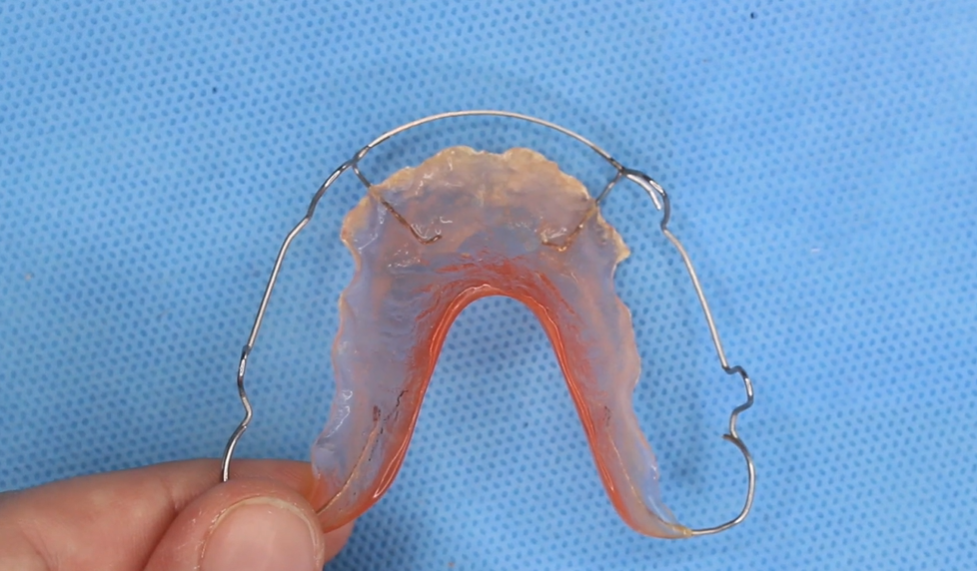If you buy through links on our site, we may earn a small affiliate commission to help support the blog - at no extra cost to you. It never influences our product selection process. Thank you!
Are you looking for the best teeth cleaning products to brighten your smile? A radiant smile isn’t just about aesthetics—it’s a reflection of your overall oral health and can significantly impact your confidence in social and professional settings.
In today’s market, you’ll find countless options for teeth cleaning products, from traditional toothbrushes and flosses to innovative sonic cleaners and whitening answers. Handling these choices can feel overwhelming, but selecting the right products for your exact dental needs is crucial for maintaining optimal oral hygiene and preventing common issues like cavities, gum disease, and staining.
Understanding the Importance of Dental Hygiene
Dental hygiene forms the foundation of oral health, directly impacting your overall wellbeing and quality of life. Regular cleaning prevents plaque buildup, which harbors bacteria that cause tooth decay and gum disease. Maintaining a consistent oral care routine doesn’t just preserve your smile—it protects your entire body from potential health complications.
One of my patients, Sarah, ignored her dental hygiene for years due to dental anxiety. When she finally visited our office, she had developed severe gum disease and multiple cavities. After implementing a proper cleaning routine with appropriate products, her oral health dramatically improved within months.
Research from the American Dental Association confirms that poor oral hygiene correlates with serious health conditions including heart disease, diabetes, and respiratory infections. Bacteria from infected gums can enter your bloodstream and affect vital organs throughout your body. Daily brushing and flossing remove these harmful bacteria before they cause damage.
“I’ve seen countless patients transform their health by simply upgrading their dental hygiene practices,” notes Dr. Todd B. Harris. “The mouth truly serves as a window to your body’s overall health status.”
The economic impact of neglecting dental hygiene adds up quickly. Preventive care costs significantly less than restorative treatments like fillings, root canals, and extractions. A $5 toothbrush and $3 floss used consistently save thousands in potential dental work.
Children benefit enormously from early dental hygiene education. Habits formed in childhood typically continue into adulthood, establishing lifelong patterns for oral health. Parents who demonstrate proper brushing techniques and make oral care enjoyable help their children avoid future dental problems.
Dental hygiene products have evolved dramatically in recent decades, offering specialized answers for different oral health needs. Electric toothbrushes remove up to 21% more plaque than manual alternatives, while water flossers reach areas traditional floss might miss.
Types of Teeth Cleaning Products
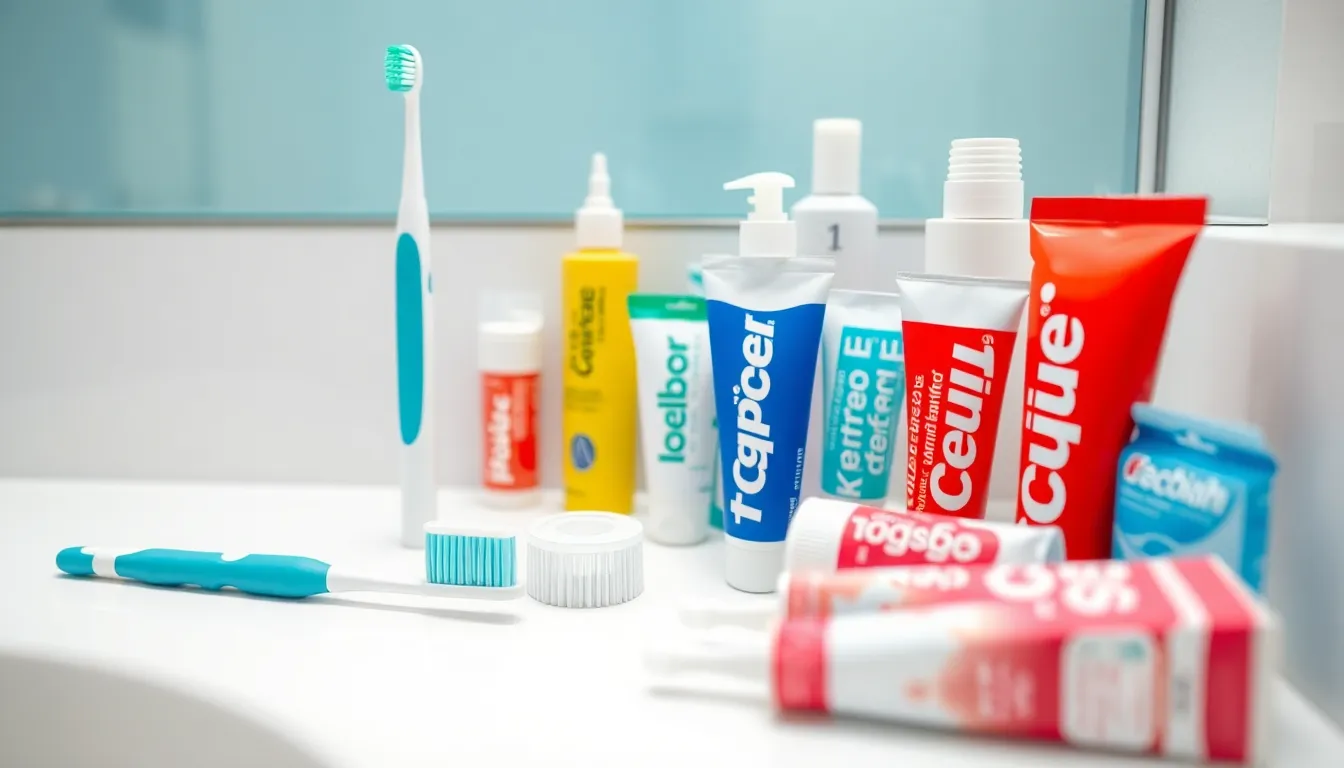
The market offers diverse dental cleaning tools designed for exact oral hygiene needs. Each product category provides unique benefits for maintaining optimal dental health and preventing common issues like plaque buildup, cavities, and gum disease.
Manual Toothbrushes
Manual toothbrushes represent the traditional approach to daily dental care with their straightforward design and accessibility. These brushes come in various bristle textures (soft, medium, hard) and head sizes to accommodate different mouth shapes and sensitivity levels. Proper brushing technique plays a crucial role in effective plaque removal, requiring a gentle circular motion for at least two minutes. Many dental professionals recommend soft bristles to prevent enamel damage and gum recession while still effectively cleaning teeth surfaces. Manual brushes offer portability, affordability, and control without requiring batteries or charging, making them ideal for travel situations.
Dr. Harris notes, “I’ve had patients maintain perfect oral health for decades using nothing but a basic manual toothbrush and proper technique. The tool matters less than the consistency and method of use.”
Electric Toothbrushes
Electric toothbrushes deliver enhanced cleaning power through motorized movements that outperform manual brushing for most users. These devices use either oscillating-rotating technology with small, round heads that rotate back and forth, or sonic technology generating high-frequency vibrations up to 31,000 strokes per minute. Premium models like Philips Sonicare and Oral-B Pro series feature built-in timers ensuring adequate brushing duration, pressure sensors preventing excessive force, and multiple cleaning modes customized to exact needs such as whitening or sensitive teeth. Clinical studies demonstrate electric toothbrushes remove up to 21% more plaque and reduce gingivitis by 11% compared to manual brushing after three months of use.
A patient named Michael shared, “Switching to an electric toothbrush completely transformed my dental checkups. After years of hearing I needed to brush better, my hygienist immediately noticed the difference and asked what had changed in my routine.”
Toothpastes and Their Ingredients
Toothpastes contain specialized formulations addressing various dental concerns while delivering essential cleaning benefits. Most effective toothpastes include fluoride (typically sodium fluoride or stannous fluoride) at concentrations between 1,000-1,500 parts per million to strengthen enamel and prevent decay. Mild abrasives like hydrated silica or calcium carbonate help remove surface stains and plaque without damaging tooth structure. Specialized varieties target exact issues—potassium nitrate or strontium chloride for sensitivity relief, pyrophosphates for tartar control, and hydrogen peroxide for whitening effects. Antimicrobial ingredients such as triclosan or stannous fluoride combat bacteria responsible for bad breath and gum disease.
Dental Floss and Interdental Cleaners
Interdental cleaning tools reach crucial spaces between teeth where toothbrushes can’t access, removing up to 40% of plaque that brushing alone misses. Traditional dental floss comes in waxed, unwaxed, and flavored varieties, effectively cleaning tight contacts between teeth when used with proper technique. Floss picks provide easier handling for those with dexterity challenges or reaching back teeth. Interdental brushes with small bristled heads work excellently for larger spaces, particularly around dental work or gum recession areas. Water flossers like the Waterpik Aquarius use pressurized water streams to flush out debris and bacteria, reducing bleeding and inflammation by 37% compared to string floss according to clinical studies.
Advanced Teeth Cleaning Technologies
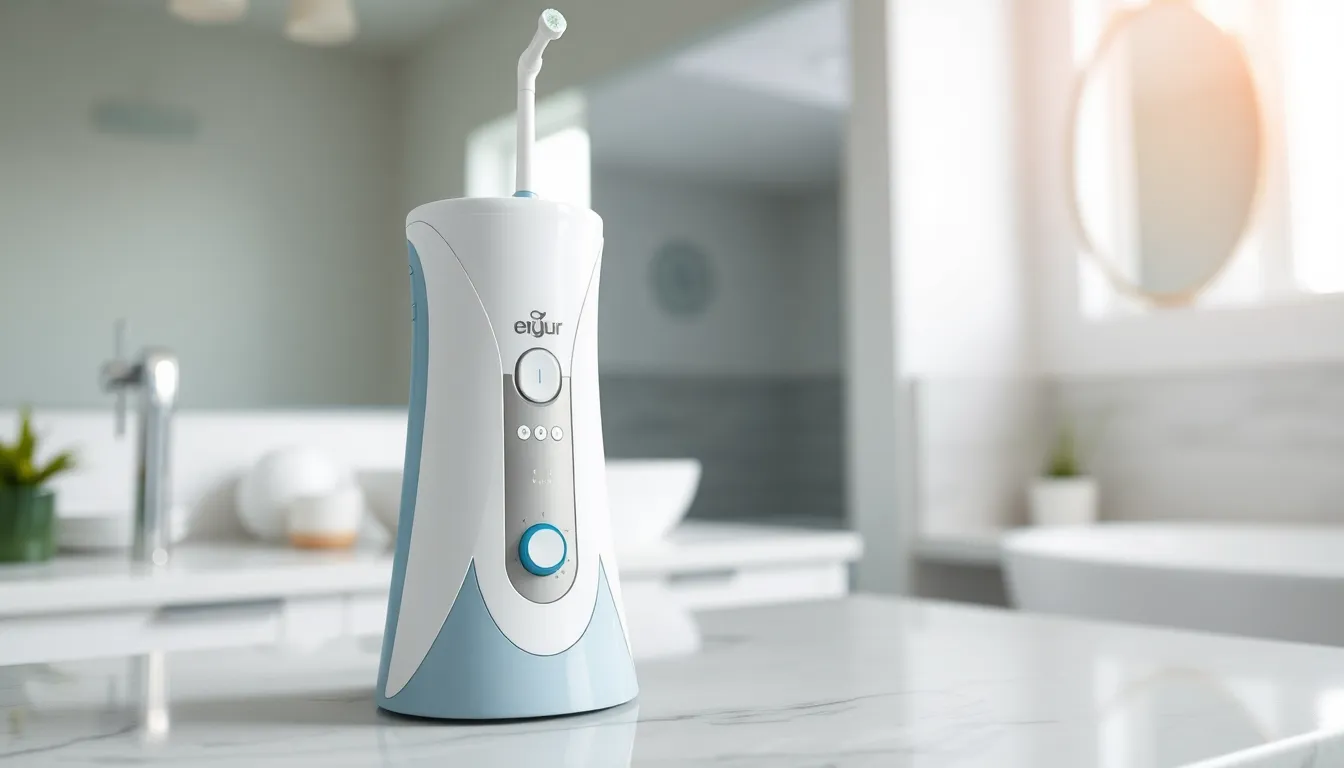
Advanced teeth cleaning technologies have revolutionized oral care routines, offering more effective and comfortable answers than traditional methods. These innovations help remove plaque and tartar with greater precision while improving overall oral health outcomes.
Water Flossers
Water flossers represent a important advancement in interdental cleaning technology, using pulsating high-pressure water jets to clean between teeth and along the gumline. They provide an excellent alternative for those who struggle with traditional string flossing due to dexterity issues or orthodontic appliances. With adjustable pressure settings, you can customize your cleaning experience based on your sensitivity level or exact plaque removal needs. Research indicates that water flossers often outperform traditional floss in reducing inflammation and removing plaque from hard-to-reach areas. Many patients with gum sensitivity report less bleeding and improved comfort when switching to water flossing as part of their daily routine.
Ultrasonic Cleaners
Ultrasonic cleaners employ sophisticated technology to transform dental cleaning experiences through high-frequency vibration. These professional-grade devices break down plaque and tartar on tooth surfaces more efficiently than manual tools. You’ll notice the difference immediately as ultrasonic cleaners operate more quietly and with less invasiveness than conventional scraping instruments. Their precision targeting helps remove stubborn deposits while minimizing gum irritation and discomfort. Modern dental practices increasingly combine ultrasonic technology with laser assistance for enhanced cleaning outcomes. Patients consistently report more comfortable cleaning sessions and shorter recovery times following ultrasonic treatments compared to traditional scaling methods. The technology proves particularly beneficial for those with sensitive gums or extensive tartar buildup that requires thorough yet gentle removal.
Natural and Alternative Teeth Cleaning Products

Natural and alternative oral care products have gained immense popularity among health-conscious consumers seeking gentler yet effective answers for their dental care routines. These products harness the power of herbal and natural ingredients to provide antibacterial, anti-inflammatory, and plaque-reducing benefits without harsh chemicals.
Charcoal-Based Products
Charcoal-based toothpastes and powders have become a trendy option for those seeking natural whitening answers. These products work by scrubbing away surface stains on teeth through their abrasive properties. Research shows that while charcoal effectively removes surface discoloration, its abrasive nature can potentially wear down tooth enamel when used excessively. Enamel erosion increases dental sensitivity and makes teeth more vulnerable to decay over time.
One of our readers, Jamie, shared: “I was using charcoal powder daily for whitening until my dentist noticed early signs of enamel wear. Now I limit use to once weekly and my teeth still look great without the damage.”
For optimal results, use charcoal products sparingly and preferably under dental professional guidance. The American Dental Association recommends looking for charcoal products with their seal of approval to ensure they meet safety standards for enamel protection.
Oil Pulling Answers
Oil pulling represents an ancient oral hygiene practice that involves swishing oils like coconut, sesame, or sunflower in your mouth for 5-20 minutes. Coconut oil stands out as particularly effective due to its lauric acid content, which exhibits powerful antibacterial properties. This natural compound helps reduce harmful oral bacteria, decrease plaque formation, and minimize gum inflammation.
Studies indicate that regular oil pulling increases saliva production, providing a natural cleansing mechanism for your mouth while reducing halitosis (bad breath). This technique serves as an excellent complement to regular brushing and flossing rather than a replacement.
Dr. Todd B. Harris notes: “Many of my patients who incorporate oil pulling into their morning routines report fresher breath throughout the day and reduced gum sensitivity. I recommend starting with just 5 minutes of coconut oil swishing and gradually increasing the duration as you become comfortable with the practice.”
When selecting natural oral care products, look for those containing additional beneficial ingredients such as turmeric, aloe vera, neem, green tea, or xylitol. These components provide supplementary antibacterial effects and help strengthen teeth and gums naturally. For remineralization benefits, products containing calcium carbonate or hydroxyapatite can support enamel repair and cavity prevention.
Best Practices for Using Teeth Cleaning Products
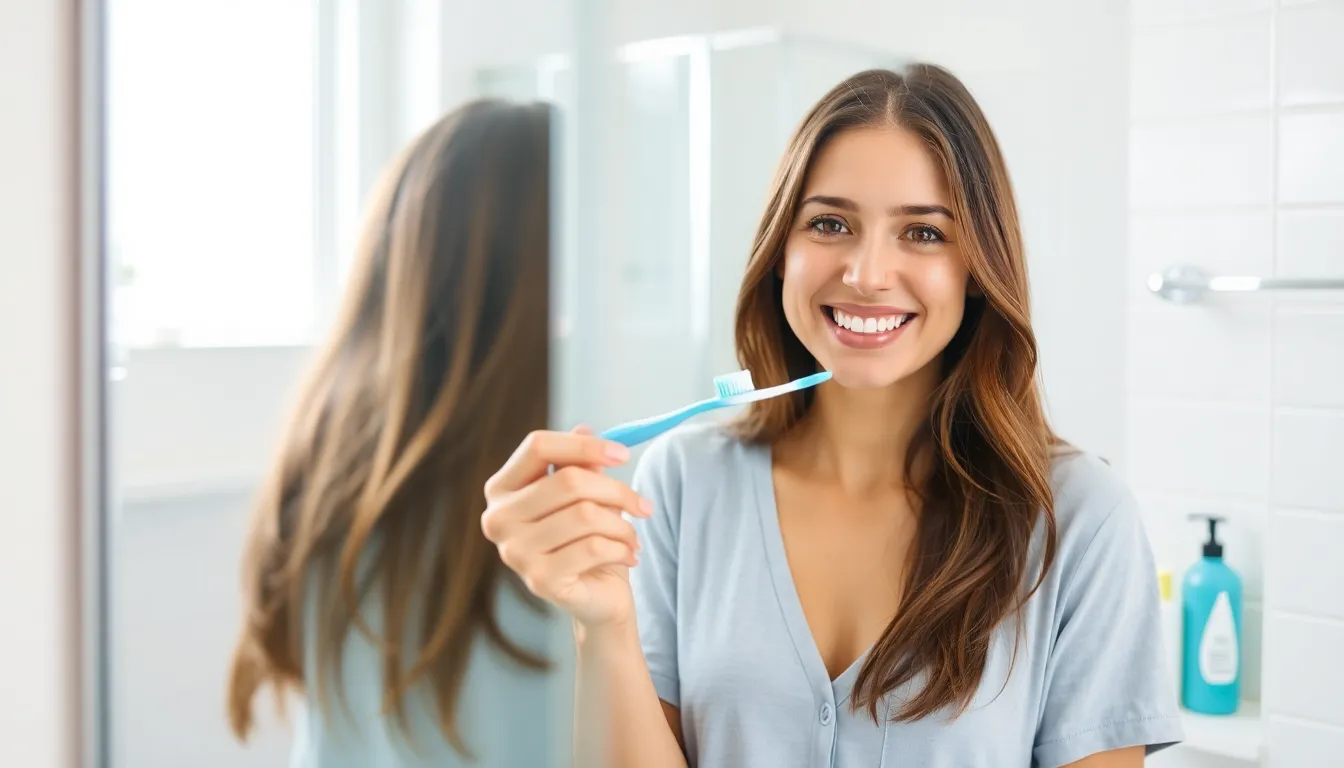
Effective teeth cleaning habits protect your oral health and prevent costly dental problems. Following dentist-recommended practices ensures you’re getting the most from your dental products while maintaining optimal hygiene.
Daily Cleaning Routine
Brush your teeth twice daily for two minutes with fluoride toothpaste to maintain healthy teeth and gums. Choose a soft-bristled toothbrush to protect your enamel and gum tissue from damage during cleaning. Electric toothbrushes often provide more thorough cleaning with less effort, making them ideal for people with limited dexterity or those seeking enhanced plaque removal.
Flossing once daily removes plaque and food particles from between teeth where your toothbrush can’t reach. Traditional string floss works effectively, but many patients find floss picks or water flossers more comfortable and easier to use. Dr. Harris often tells his patients, “I can always tell which of my patients floss regularly just by looking at their gum health.”
Incorporate an antibacterial mouthwash into your routine to reduce bacteria and freshen breath after brushing and flossing. Don’t forget to clean your tongue using a dedicated tongue scraper or your toothbrush, as the tongue harbors bacteria that contribute to bad breath and oral health issues.
Regular dental check-ups every six months allow professionals to catch potential problems early and provide thorough cleanings that remove stubborn plaque and tartar buildup.
Product Replacement Schedule
Replace your toothbrush or electric toothbrush head every 3-4 months to maintain cleaning effectiveness. Frayed bristles indicate earlier replacement is needed regardless of timeframe. One patient, Maria, shared how switching to a regular replacement schedule dramatically reduced her plaque buildup at check-ups.
Discard dental floss or floss picks after each use to prevent bacterial transfer. Store mouthwash properly and check expiration dates, as expired products lose their effectiveness and may harbor bacteria. Toothpaste should be replaced if you notice changes in texture, color, or taste.
Tongue cleaners require regular cleaning to prevent bacterial buildup, with plastic versions needing replacement every 3-4 months. Metal tongue scrapers last longer but still need proper sanitizing between uses.
Maintaining this replacement schedule ensures your teeth cleaning tools remain effective and hygienic, supporting your overall oral health efforts and preventing the transfer of harmful bacteria.
Choosing the Right Products for Your Dental Needs
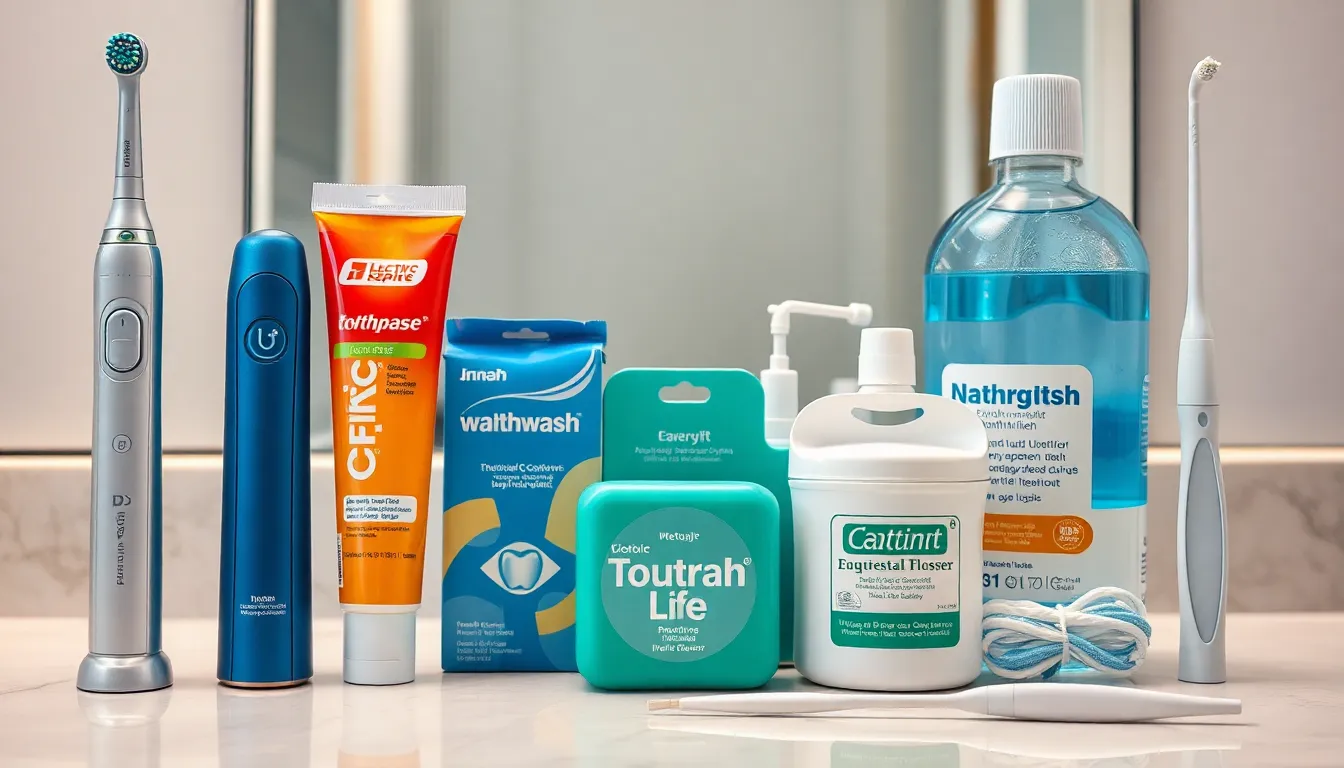
Toothbrushes: Manual vs. Electric
Electric toothbrushes offer superior cleaning power with advanced features that enhance your brushing routine. Models like the Oral-B Pro 3 come equipped with pressure sensors that protect your gums while ensuring thorough plaque removal. Many patients report important improvements after switching to electric options, especially those with dexterity issues. Manual brushes with high-density bristles, such as those from STIM, provide effective cleaning when used with proper technique and come in various stiffness options for different needs.
Toothpaste Formulations
Toothpaste selection depends on your exact dental concerns and priorities. Fluoride-based formulations remain the gold standard for cavity prevention according to dental experts. Whitening varieties like Marvis Whitening Mint effectively remove surface stains and gradually brighten your smile. Specialized options target sensitivity, gum health, or natural ingredients preferences to address individual concerns.
Flossing Tools and Interdental Cleaners
Traditional dental floss works well for basic cleaning between teeth, but modern alternatives offer enhanced benefits. Water flossers like the Aquasonic Aqua Flosser are clinically proven more effective than string floss for removing food particles and plaque. STIM Interdental Brushes provide excellent cleaning for braces, implants, and wide spaces between teeth. These tools help reach areas regular brushing misses, reducing your risk of gum disease and cavities.
Supplementary Products
Mouthwash complements your brushing and flossing routine by reaching areas other tools might miss. Alcohol-free options such as Perfora Lemon Mint promote gum health without causing irritation or dry mouth. Tongue cleaners from STIM effectively remove bacteria from your tongue’s surface, significantly reducing bad breath. Whitening pens and gels containing carbamide peroxide deliver targeted stain removal with fast results for special occasions or maintenance between professional treatments.
Conclusion
Choosing the right teeth cleaning products can transform your oral health journey. From traditional toothbrushes to advanced water flossers and natural alternatives there’s a solution for every dental need. Remember that consistency matters more than complexity.
Your smile deserves daily attention with proper brushing flossing and supplementary products customized to your exact requirements. Replace your tools regularly and don’t skip those dental check-ups.
By investing in quality dental products and following recommended cleaning routines you’ll not only prevent costly treatments but also contribute to your overall health. A bright healthy smile is within your reach—it just takes the right tools and techniques to maintain it.
Frequently Asked Questions
How often should I replace my toothbrush?
Replace your toothbrush or electric toothbrush head every 3-4 months, or sooner if the bristles become frayed. Worn bristles don’t clean effectively and can harbor bacteria. After illness, it’s also a good idea to get a new toothbrush to prevent reinfection. Regular replacement ensures optimal cleaning performance and helps maintain your oral health.
Are electric toothbrushes better than manual ones?
Electric toothbrushes often provide superior cleaning because they deliver thousands of brush strokes per minute and include features like timers and pressure sensors. They’re particularly beneficial for people with limited dexterity or orthodontic appliances. However, a manual toothbrush used with proper technique can still be effective. The best choice depends on your specific dental needs and preferences.
Is fluoride toothpaste necessary for good oral health?
Yes, fluoride toothpaste is essential for most people. Fluoride strengthens tooth enamel and helps prevent cavities by making teeth more resistant to acid attacks from bacteria. The American Dental Association recommends fluoride toothpaste as part of a comprehensive oral hygiene routine. Only in specific cases, such as for very young children or those with certain medical conditions, might fluoride-free alternatives be recommended.
How effective are water flossers compared to traditional floss?
Water flossers are often more effective than traditional floss, especially for people with braces, dental implants, or dexterity issues. Research shows they can reduce gum bleeding and inflammation more effectively than string floss. They’re excellent at removing food particles and plaque between teeth and below the gumline. However, traditional floss still provides the mechanical scraping action that some dental professionals prefer.
Are charcoal teeth whitening products safe to use?
Charcoal whitening products should be used with caution. While they may remove surface stains, their abrasive nature can wear down tooth enamel over time, potentially causing sensitivity and increased risk of cavities. Dental professionals generally recommend using them sparingly, if at all, and opting for gentler whitening methods approved by the American Dental Association. Always consult your dentist before using trendy whitening products.
What’s the proper way to brush teeth?
Brush for two minutes twice daily using a soft-bristled toothbrush and fluoride toothpaste. Hold the brush at a 45-degree angle to your gums and use gentle, short back-and-forth strokes. Clean all surfaces: outer, inner, and chewing. Don’t forget to brush your tongue to remove bacteria. Avoid aggressive scrubbing, which can damage gums and enamel. Replace your toothbrush every 3-4 months.
Is oil pulling an effective teeth cleaning method?
Oil pulling (swishing oil in your mouth) may offer some benefits as a supplementary practice. Studies suggest it can reduce harmful bacteria and improve gum health when used consistently. However, scientific evidence remains limited, and it should not replace brushing, flossing, and regular dental visits. If you choose to try oil pulling, use coconut oil for 15-20 minutes before brushing your teeth.
How can I prevent teeth staining?
Prevent teeth staining by limiting consumption of staining substances like coffee, tea, red wine, and tobacco. Rinse your mouth with water after consuming these items. Brush twice daily with whitening toothpaste, floss regularly, and schedule professional cleanings every six months. Consider using a straw when drinking staining beverages. For existing stains, talk to your dentist about professional whitening options or appropriate at-home treatments.
Do mouthwashes provide significant oral health benefits?
Yes, therapeutic mouthwashes can provide significant benefits when used as part of a complete oral care routine. Antibacterial mouthwashes help reduce plaque, prevent gingivitis, and combat bad breath. Fluoride rinses strengthen enamel and provide additional cavity protection. However, mouthwash is a supplement to, not a replacement for, brushing and flossing. Choose alcohol-free options if you experience dry mouth or sensitivity.
How important is flossing if I brush thoroughly?
Flossing is essential even with thorough brushing. Your toothbrush can’t reach between teeth or below the gumline where plaque accumulates and causes decay and gum disease. Flossing removes these hidden deposits, reducing your risk of cavities between teeth and periodontal problems. For optimal oral health, floss at least once daily before or after brushing. If traditional floss is difficult, try interdental brushes or water flossers.






